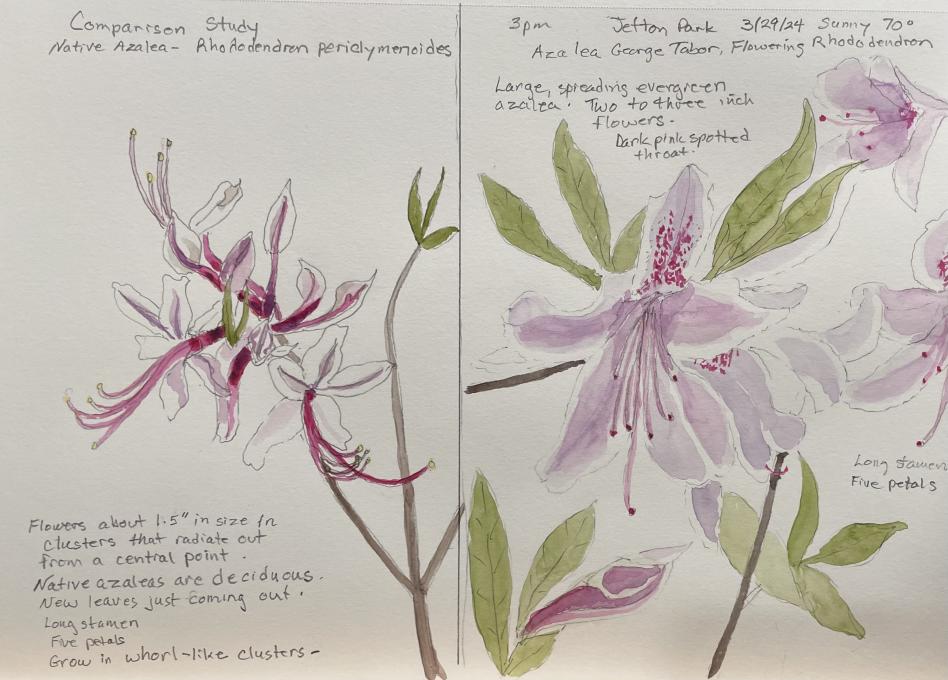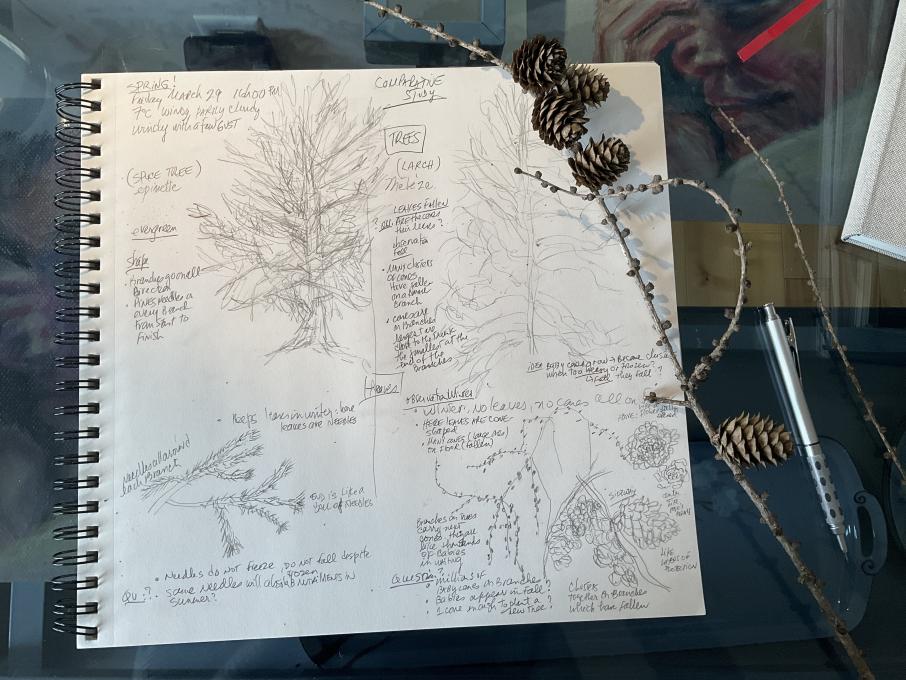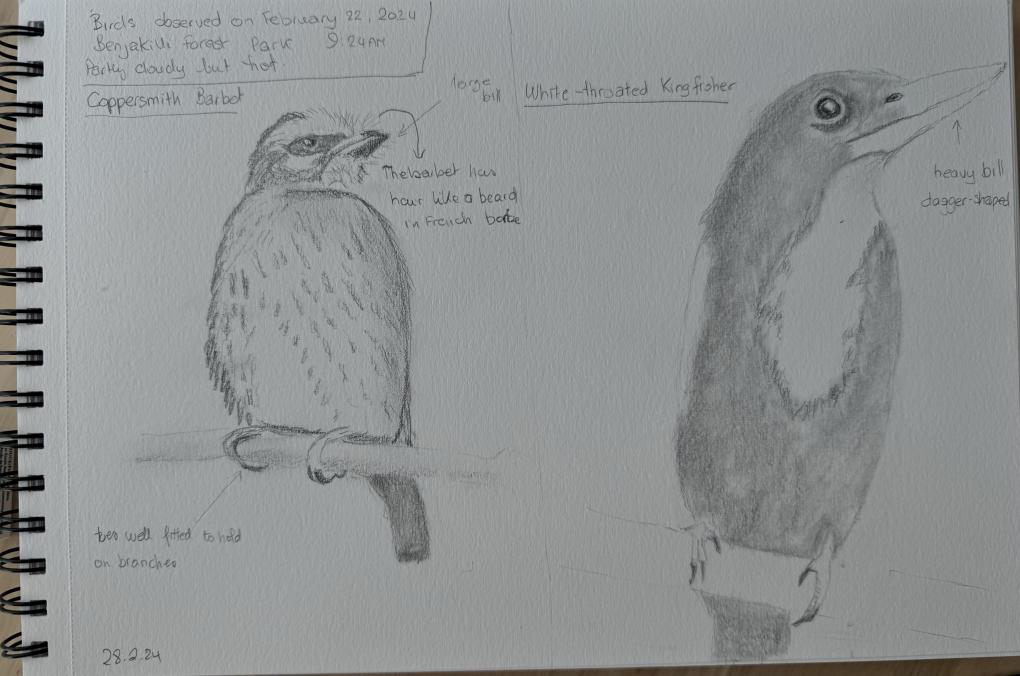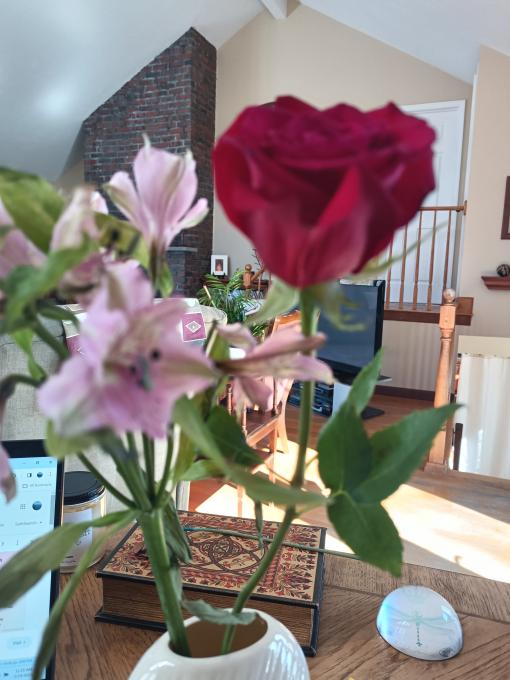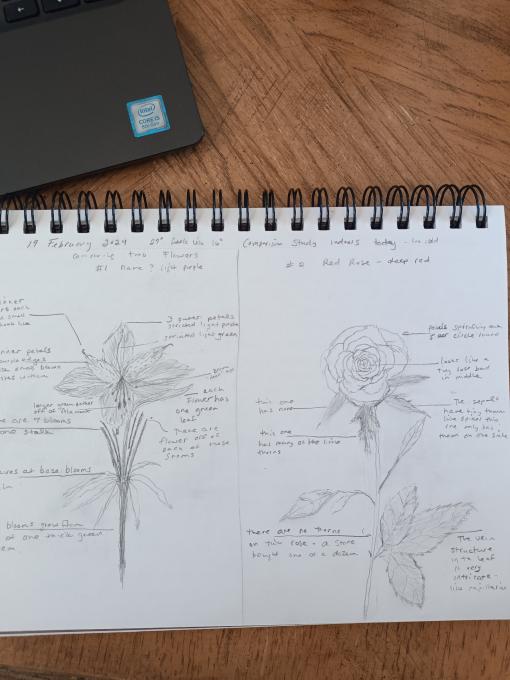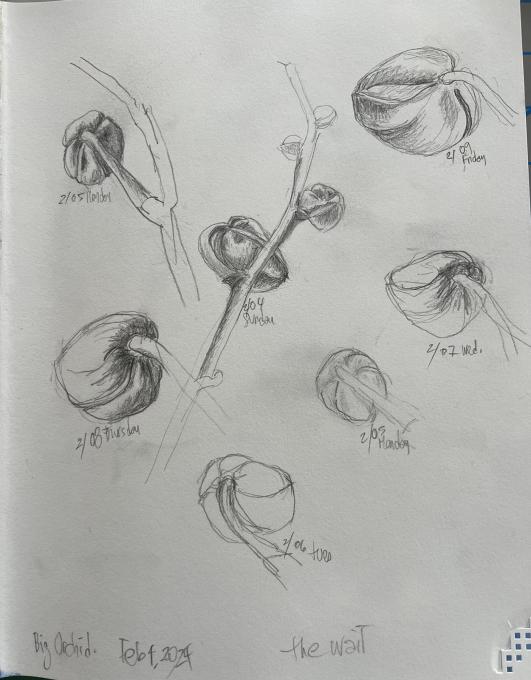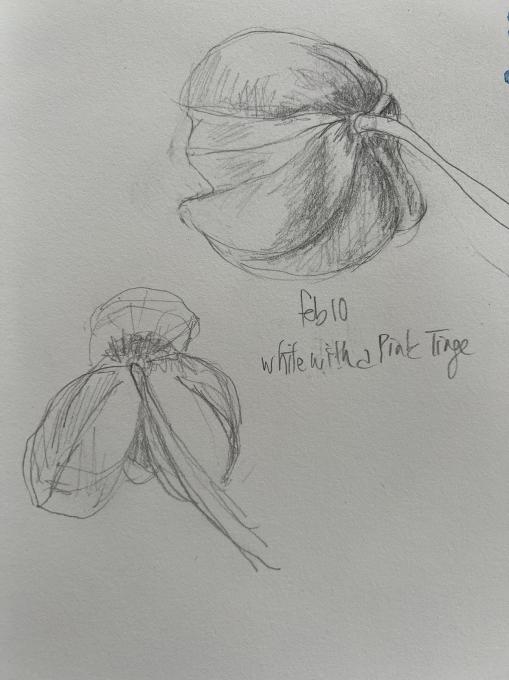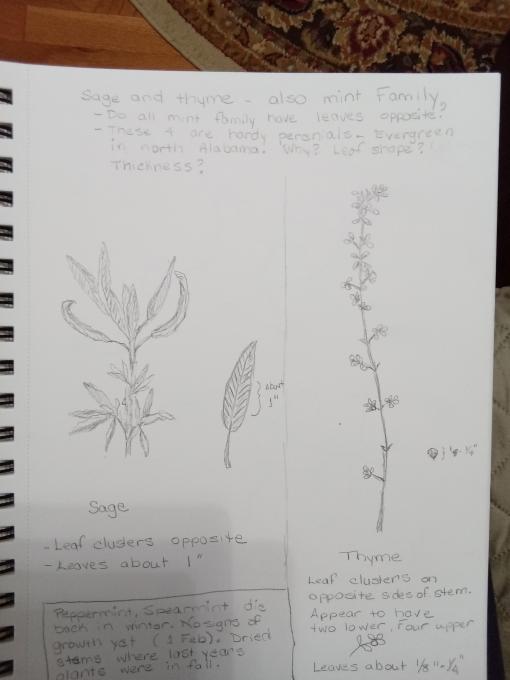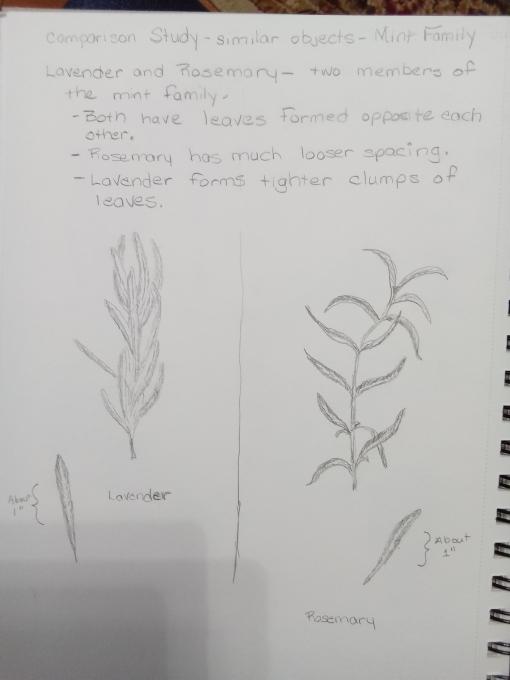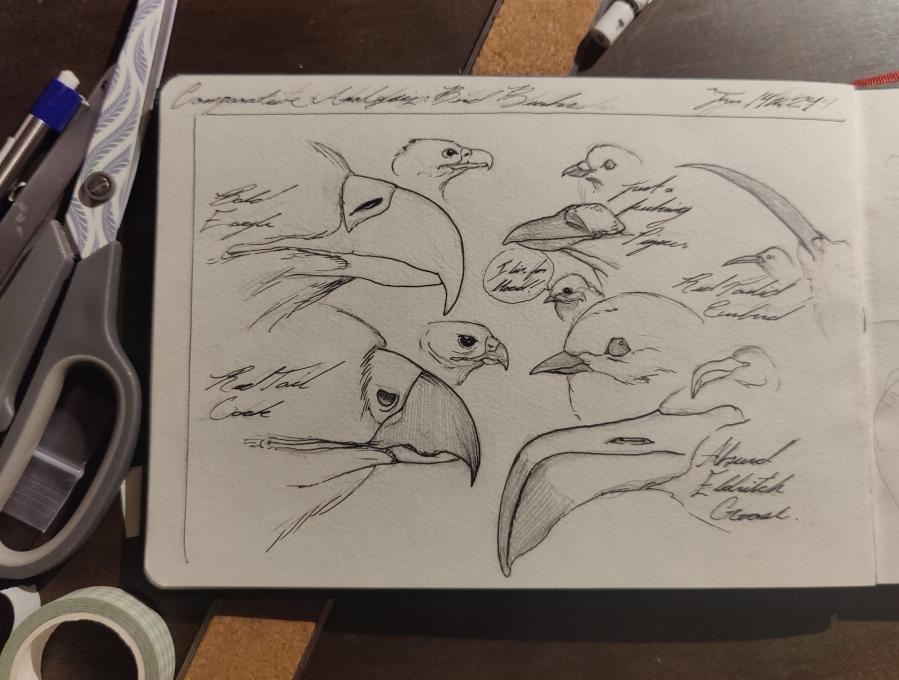The Cornell Lab Bird Academy › Discussion Groups › Nature Journaling and Field Sketching › The Power of Comparison
-
Two herbs in the same pot. I never realized that the part of the lavender plant that’s inside sachets is the bud, harvested before it flowers. I love lavender; it reminds me of my grandmother, who also loved it. I like basil for a different reason: the taste! I never noticed before that the basil flower is like a little orchid. Both lavender and basil are in the mint family, it turns out.

-
I really enjoyed this exercise. I chose two flowers in my flower bed. The one is petunia and I have no idea what the other is. Both flowers are similar color, but so many differences. The flower on the left is small and has feathery leaves, much more delicate than the petunia. It is on long slender stems and long narrow leaves as compared to the petunia which is a much larger flower with a strong line of color running in the center of each petal. Also the petunia has clusters of large round shaped leaves. This course is helping me to look closer at everything, not just when I am sketching and I love it.
-

-
I did a comparison drawing of two flowers in my yard, allium and meadow phlox. I discovered they are similar in that each flower is comprised of many small flowers. However, a close inspection revealed a number of differences between the individual flowers of each plant beyond the obvious color difference: the number of petals, the shape of the petals, the shape of the flower, the length of the stamen, the existence of small leaves under the flower. Taking the time to look closely and draw what I see is almost meditative!

-
 Comparison between Gulf Fritillary Butterfly and Mourning Cloak. I cheated by using my camera to capture the image so I could get good detail. However, in defense of myself, I found it very enlightening.
Comparison between Gulf Fritillary Butterfly and Mourning Cloak. I cheated by using my camera to capture the image so I could get good detail. However, in defense of myself, I found it very enlightening. 

-
Autumn Joy and Rudbeckia Comparison

-
I enjoyed this exercise, as it challenged me to really look at both plants and see the similarities/differences. I wasn't used to paying such focused attention to details such as buds, petals, stems, leaves/veins, overall shape, etc. but as I did I noticed more than I would have just perusing them in my yard. I thought of questions such as: did the broad leaves of both plants catch more water/sunlight than smaller ones would have? Do bees ever come to flowers such as cyclamen and geraniums? What is the affect on propagation of a bulb v.s. a root plant? Do the shapes of these flowers enhance their survival, assuming a receptive environment? I hadn't been aware of these before.
-

-
You have really good handwringing skills!
-
-

-

-

-

-
I ended up painting it, too. I saw details I never would have noticed, otherwise!

-
 Tulsi plant and Ixora. Both are small and new to my garden. I definitely need a large hat. Got very glarey out there. I was pleasantly surprised to see how many questions I asked myself. And I carried a ruler.
Tulsi plant and Ixora. Both are small and new to my garden. I definitely need a large hat. Got very glarey out there. I was pleasantly surprised to see how many questions I asked myself. And I carried a ruler.
-
Crazy sequence. Working through my Bird Academy class after a travel break. Since I picked some beloved daffodils this morning, I decided to compare two similar ones. What are the part names? I wondered. Looked them up. Found images on the Daffodil Society pages. There's a daffodil society? I looked around the page. There is a National Daffodil Show? Where? 35 minutes from where I live? When? Next week! Now it is on my calendar. I just love daffodils!
-

-

I compared a spruce tree to a larch tree in my front yard. The weather is still cold so I did most inside, and went outside to sketch the branches.
I discovered many details I had never noticed before about each of the tree.
This summer, will observe the leaves growth and fall to answer all the questions generated by the comparative study.
Thank you. This exercise opens our eyes. Elaborating the comparative study in my sketchbook gives an outstanding sketch page. -
I compared a sedge and a grass. I noticed how much wider the blades were on the sedge and they seemed sharper. The grass was softer, willowy. The sedge seemed to be encapsulated at the bottom where the blades and stem emerged. The grass seemed to emerge form the root.
-

I live in the center of Bangkok. We do have a beautiful park in the middle of the city. It is where I took these pictures 3 days ago. It is hot right now so I did my observations from these pictures. I am not that good with proportions yet -
Yes, I compared two plants in the Studio. Since its winter, not much is growing.
Both plants have nodules where the leaves come out. Both are messy when the plant leaves die out, and both extend to the light.
Both fian fine fuzzy hairs, but the Moses Plant flower has small seeds that have hairs, which I think would make the wind carry it away to repopulate in another area. This plant is easy to root in water. The flower on this is a pink/maroon colour. Never paid attention to the flower heads that turn into seed before. Kept the seed heads and will either do a germination test, or plant out.
The second plant, I cannot seem to identify. Its in its third year growing and it spindly. I have cut it back before in the spring, when the plants go out , and it comes back. IT has small white nodule flowers with a flower but and two oblong petals beside the head. -
I did the comparison with some Valentine/Birthday flowers because it is cold here today!


-


This is a slightly different approach to comparison. I rescued a moth orchid two years ago and have never seen it bloom until today. Anticipating the miracle of finally finding out its color, all last week, I drew the lead bud every day, practicing my foreshortening skills and comparing the minute changes in the shape of the bud. -

-

-
My artist partner is sketching alongside me and decided to do comparative studies on bird beaks, since some of the previous bird exercises had him noticing that they're a very weird structure and crucial to communicating the specific type of bird being depicted. (I did some different mosses we found on a hike). Aren't they cool!

-
I love the beak study. I wish I could draw like your artist friend!
-
Read More:



 Comparison between Gulf Fritillary Butterfly and Mourning Cloak. I cheated by using my camera to capture the image so I could get good detail. However, in defense of myself, I found it very enlightening.
Comparison between Gulf Fritillary Butterfly and Mourning Cloak. I cheated by using my camera to capture the image so I could get good detail. However, in defense of myself, I found it very enlightening. 








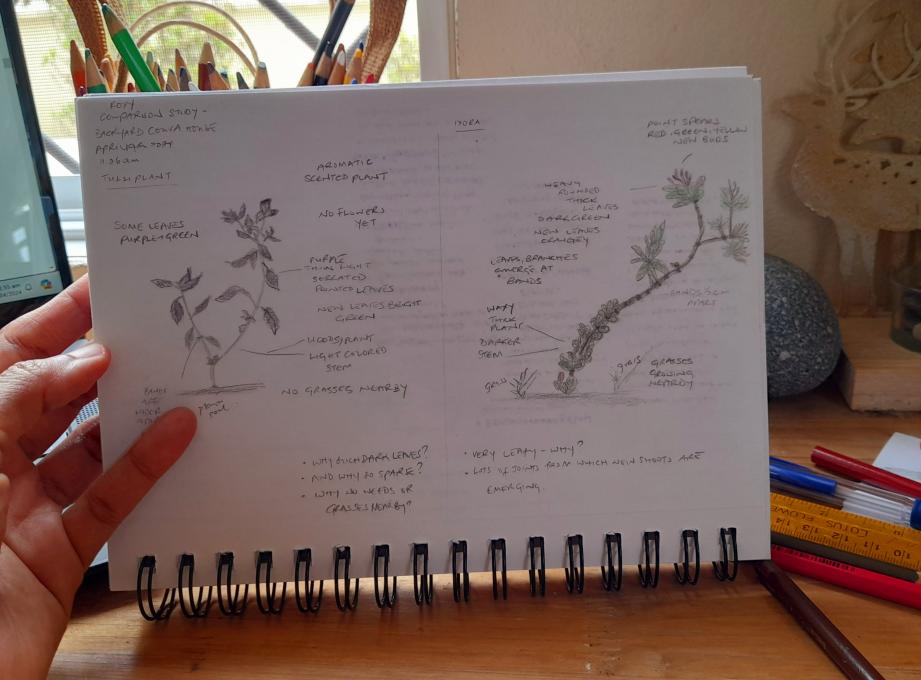 Tulsi plant and Ixora. Both are small and new to my garden. I definitely need a large hat. Got very glarey out there. I was pleasantly surprised to see how many questions I asked myself. And I carried a ruler.
Tulsi plant and Ixora. Both are small and new to my garden. I definitely need a large hat. Got very glarey out there. I was pleasantly surprised to see how many questions I asked myself. And I carried a ruler.